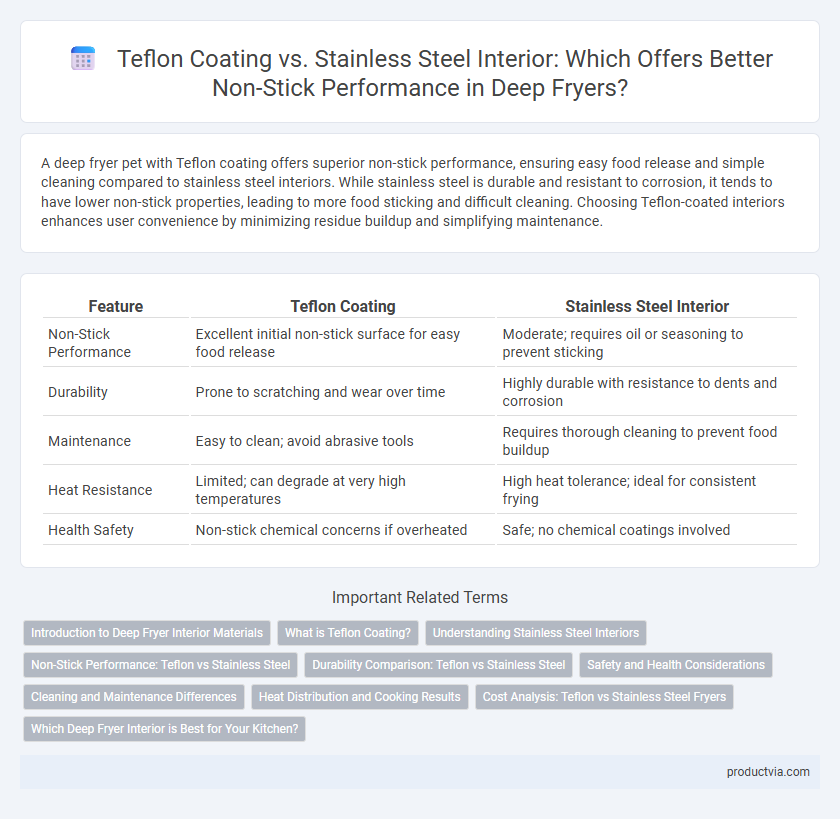A deep fryer pet with Teflon coating offers superior non-stick performance, ensuring easy food release and simple cleaning compared to stainless steel interiors. While stainless steel is durable and resistant to corrosion, it tends to have lower non-stick properties, leading to more food sticking and difficult cleaning. Choosing Teflon-coated interiors enhances user convenience by minimizing residue buildup and simplifying maintenance.
Table of Comparison
| Feature | Teflon Coating | Stainless Steel Interior |
|---|---|---|
| Non-Stick Performance | Excellent initial non-stick surface for easy food release | Moderate; requires oil or seasoning to prevent sticking |
| Durability | Prone to scratching and wear over time | Highly durable with resistance to dents and corrosion |
| Maintenance | Easy to clean; avoid abrasive tools | Requires thorough cleaning to prevent food buildup |
| Heat Resistance | Limited; can degrade at very high temperatures | High heat tolerance; ideal for consistent frying |
| Health Safety | Non-stick chemical concerns if overheated | Safe; no chemical coatings involved |
Introduction to Deep Fryer Interior Materials
Deep fryer interior materials significantly influence non-stick performance and maintenance. Teflon coating offers superior non-stick properties, allowing easy food release and quick cleaning, but may wear off over time and require careful handling to avoid scratching. Stainless steel interiors provide durability and resistance to corrosion, though they may require oil seasoning or non-stick sprays to prevent food from sticking during frying.
What is Teflon Coating?
Teflon coating is a brand name for polytetrafluoroethylene (PTFE), a synthetic fluoropolymer renowned for its exceptional non-stick properties and chemical resistance in deep fryers. Unlike stainless steel interiors, which provide durability and easy cleaning but lack inherent non-stick ability, Teflon-coated surfaces significantly reduce food adhesion, allowing for healthier cooking with less oil and effortless cleanup. However, Teflon coatings require careful maintenance to avoid scratches or high heat damage that can compromise their non-stick performance over time.
Understanding Stainless Steel Interiors
Stainless steel interiors in deep fryers provide durable, corrosion-resistant surfaces that ensure long-lasting performance without the risk of chipping or peeling seen in Teflon coatings. While Teflon offers superior non-stick properties for easy food release, stainless steel requires proper seasoning and oiling to enhance its natural non-stick capabilities. Choosing stainless steel interiors ensures a safer cooking environment free from chemical breakdown at high temperatures commonly reached during frying.
Non-Stick Performance: Teflon vs Stainless Steel
Teflon coating provides superior non-stick performance in deep fryers, allowing food to release easily and minimizing oil absorption for healthier frying. Stainless steel interiors, while durable and resistant to scratching, often require additional oil or non-stick sprays to prevent food from sticking during cooking. For effortless cleanup and consistent non-stick results, Teflon-coated surfaces outperform stainless steel in deep fryer applications.
Durability Comparison: Teflon vs Stainless Steel
Teflon coating on deep fryers offers excellent initial non-stick performance but tends to degrade over time due to scratches and high heat exposure, reducing durability. Stainless steel interiors provide long-lasting durability and resist wear, maintaining structural integrity despite potentially lower initial non-stick properties. For heavy-duty use, stainless steel is preferred due to its superior resistance to corrosion and physical damage, extending the lifespan of the fryer.
Safety and Health Considerations
Teflon-coated interiors in deep fryers offer superior non-stick performance, reducing oil usage and easing cleanup; however, overheating Teflon can release harmful fumes posing health risks. Stainless steel interiors lack a non-stick surface but provide a safer option by avoiding chemical coatings and ensuring durability without toxin release. Choosing stainless steel prioritizes health and safety by preventing exposure to potentially hazardous chemicals under high-temperature cooking conditions.
Cleaning and Maintenance Differences
Teflon-coated deep fryer interiors offer superior non-stick performance, making residue easy to wipe away and reducing cleaning time significantly. Stainless steel interiors require more rigorous scrubbing and specialized cleaning agents to remove stuck-on food effectively, demanding higher maintenance effort. Over time, Teflon coatings may degrade or scratch, requiring careful handling, while stainless steel surfaces maintain durability but need frequent polishing to prevent discoloration and buildup.
Heat Distribution and Cooking Results
Teflon-coated interiors in deep fryers provide excellent non-stick properties, allowing food to release easily and facilitating quick cleanup. Stainless steel interiors, while less naturally non-stick, offer superior heat distribution that ensures even cooking and consistent browning. The choice between Teflon and stainless steel impacts cooking results, with Teflon favoring ease of maintenance and stainless steel delivering more precise heat control and durability.
Cost Analysis: Teflon vs Stainless Steel Fryers
Teflon-coated deep fryers typically offer superior non-stick performance at a lower initial cost compared to stainless steel models, reducing the need for excessive oil and making cleanup easier. Stainless steel interiors, while often more expensive upfront due to durability and resistance to scratching, tend to have longer lifespans and can withstand higher cooking temperatures without degrading. Evaluating total cost of ownership involves balancing the lower replacement frequency of stainless steel fryers against the cost savings on oil and maintenance provided by Teflon coatings.
Which Deep Fryer Interior is Best for Your Kitchen?
Teflon-coated deep fryer interiors provide excellent non-stick performance, preventing food from sticking and making cleanup easier, but they may wear off over time and require careful handling to avoid scratches. Stainless steel interiors are highly durable, resistant to corrosion, and can handle higher temperatures without damage; however, they often need more oil and maintenance to prevent sticking. For kitchens prioritizing long-term durability and versatility, stainless steel is ideal, while Teflon coating suits those seeking effortless non-stick convenience.
Teflon coating vs Stainless steel interior for non-stick performance Infographic

 productvia.com
productvia.com